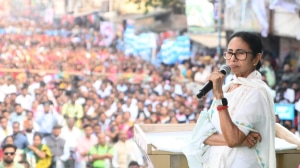Citing damage to ancient rock carvings, experts red-flag mega oil refinery project
The rock art, or petroglyphs, estimated to be 20,000 years old and classified as protected monuments by the state archaeology department and the Archaeological Survey of India, have been added to the tentative list of UNESCO’s world heritage sites.
 The petroglyphs near the site in Maharashtra’s Ratnagiri are estimated to be 20,000 years old. (Nisarga Yatri Sanstha)
The petroglyphs near the site in Maharashtra’s Ratnagiri are estimated to be 20,000 years old. (Nisarga Yatri Sanstha) The site proposed for a mega oil refinery in Barsu village of Maharashtra’s Ratnagiri district is at the centre of a row over whether it might damage ancient rock carvings found in the area.
The rock art, or petroglyphs, estimated to be 20,000 years old and classified as protected monuments by the state archaeology department and the Archaeological Survey of India, have been added to the tentative list of UNESCO’s world heritage sites.
 Nisarga Yatri Sanstha, a Ratnagiri-based non-profit organisation, has been working for the last few years to find and preserve petroglyphs in Konkan region. (Photo: Nisargyatri)
Nisarga Yatri Sanstha, a Ratnagiri-based non-profit organisation, has been working for the last few years to find and preserve petroglyphs in Konkan region. (Photo: Nisargyatri)
Known as Ratnagiri oil refinery and petrochemical complex, the project is being developed by Ratnagiri Refinery & Petrochemicals Limited, a joint venture of Indian Oil Corporation Ltd, Bharat Petroleum Corporation Ltd and Hindustan Petroleum Corporation Ltd.
The original plan to develop the project in Nanar village of Ratnagiri district was dropped in 2019 by the Devendra Fadnavis-led government due to opposition from local residents and then BJP ally Shiv Sena, who said it would impact traditional livelihoods and lead to environmental degradation. Thackeray later wrote to the Centre suggesting Barsu-Solgaon as the new site.
However, the alternative site too has run into trouble, not just with residents of Barsu village who have been citing land acquisition and environmental reasons for their opposition, but conservationists and archaeologists, who say it will end up damaging the petroglyphs.
 A state government official, however, said that the Barsu site for the refinery has not been finalised yet and is “only being considered”. (Credit- Nisargyatri)
A state government official, however, said that the Barsu site for the refinery has not been finalised yet and is “only being considered”. (Credit- Nisargyatri)
Last month, a committee of experts appointed by the Union Ministry of Science and Technology visited Ratnagiri to inspect and study the petroglyphs scattered across several villages such as Barsu, Rundhe, Devihasol, Devache Gothne, Ukshi, Chave and Kasheli, and propose measures for conserving them.
Led by senior archaeologist Professor Vasant Shinde, a CSIR Bhatnagar Fellow at Centre For Cellular And Molecular Biology (CCMB) and former Vice-Chancellor of Deccan College, Post-Graduate and Research Institute, Deemed University, Pune, the team included scientists, historians and archaeologists from premier institutes of India.
Shinde told The Indian Express that the team visited the sites to assess and make a proposal for funds required to conserve “the heritage and to study how a project can be undertaken to make the entire country and the world aware of the importance of the sites as they are unique.”
 Led by a local conservationist, Sudhir Risbud, Nisarga has discovered over 1,700 petroglyphs from more than 72 villages. (Credit- Nisargyatri)
Led by a local conservationist, Sudhir Risbud, Nisarga has discovered over 1,700 petroglyphs from more than 72 villages. (Credit- Nisargyatri)
“The government should have conducted a joint survey before allotting land for the refinery project. It should do so in future whenever it has to fix another land for the refinery project. The petroglyphs are on the tentative UNESCO list. If the project starts at Barsu, the rock carvings will get destroyed due to construction and chemical reaction at the site,” Shinde said.
“The petroglyphs can be saved if the project is shifted 5-6 kilometres away from the sites. We’ll recommend that to the government.”
More than 250 petroglyphs have been identified in the area where the petrochemical refinery will be built. Shinde said the rock carvings have not received the attention they deserve due to a lack of funding. They are in the process of sending a comprehensive proposal for the same.
“Petroglyphs and geoglyphs are considered assets across the world and cannot be shifted. We have to strike a balance between development and conservation of historical treasure. A refinery project can be set up elsewhere in Konkan but not at this site,” Shinde said.
He added: “We are planning to create a project for conservation of all petroglyphs in the Konkan region and get their carbon and geological dating done. If the government wants to come up with any other development project in the region, it needs to consider these aspects and conduct a systematic survey.”
Dr Tejas Garge, director of the Maharashtra Archaeology Department, refused to comment on the project and its possible impact on the rock art.
A state government official, however, said that the Barsu site for the refinery has not been finalised yet and is “only being considered”.
“The talks are going on at a serious level. The decision to finalise the refinery site will be taken only once all the local stakeholders are taken into confidence after resolving all the issues and their concerns about the projects,” the official said.
Petroglyphs are drawn by removing part of a rock surface by incising, picking, carving or abrading. Ratnagiri district has more than 1,500 petroglyphs, also called katal shilpa, spread across 70 sites. The carvings are in the shape of human figures, birds, animals and geometric forms, though they vary in shape and size from site to site.
Seven sites in Ratnagiri district (Ukshi, Jambharun, Kasheli, Rundhe Tali, Devihsol, Barsu and Devache Gothane), Kudopi village in Sindhudurg district, and nine sites at Pansoimol in Goa have been added to the tentative list of UNESCO’s world heritage sites.
Nisarga Yatri Sanstha, a Ratnagiri-based non-profit organisation, has been working for the last few years to find and preserve petroglyphs in Konkan region. Led by a local conservationist, Sudhir Risbud, Nisarga has discovered over 1,700 petroglyphs from more than 72 villages.
Risbud said that he had written to the district collector of Ratnagiri and the executive engineer of Maharashtra Industrial Development Corporation (MIDC), requesting them to shift the project from the proposed site at Barsu.
“The area where the factory has been proposed has two sites with around 170 petroglyphs, which are already in the tentative list of UNESCO. These structures need to be preserved and conserved as they tell us about human history and culture. In fact, these sites should be developed in a way that can attract tourists from all over the world. It’s our rich heritage.”







